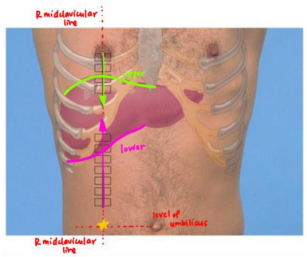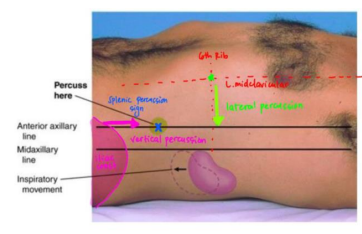Abdominal Exam
Auscultation
- Listen to all 4 quadrants (diaphragm)
- Normal bowel sounds: Gurgling, clicking, rumbling, and growling
- Abnormal bowel sounds
- High pitched, increased, or absent
- Epigastric bruits: Renal artery stenosis or renovascular hypertension
- Arterial bruits: Can indicate occlusions
- Hepatic bruits: Can indicate liver cancer or cirrhosis
- Venus hum: Can indicate liver cirrhosis
- Friction rubs: Inflammation of peritoneal surface of organ (such as from liver cancer, splenic infarct, chlamydial or gonococcal perihepatitis)
Percussion
Tympanic sounds: Drum-like, typically heard over empty, gas filled spaces like the abdomen
Resonant sounds: Low-pitched and hollow, heard in lungs or chest cavity
Dull sounds: Heard over denser spaces (like those with organs or fluids)
- Percuss all 4 quadrants (should sound tympanic)
- Percuss the stomach, pressing down from left midclavicular from costal margin to bottom of LLQ, Listen for gastric bubble.
- Percuss the liver
- Start at right midclavicular, below umbilicus. Move upward and note where the sound changes from tympanic to dull. Note this point.
- Start at right midclavicular, near 4th rib. Move downward and note where the sound changes from resonant to dull. Note this point.
- Measure between two points. Normal distance is 6-12 cm. (FYI, this is a poor test)

- Percuss the spleen
- Start at left midclavicular near rib 6. Move laterally to left anterior axillary line.
- Start at the left anterior axillar line at the iliac crest. Move upward to the lowest intercostal space.
- When at lowest intercostal space, perform splenic percussion sign (normal tidal breathing and with a deep inhale with hold)

Palpation
- Palpate all 4 quadrants, superficial then deep.
- Use your dominant hand on top of non-dominant hand
- Superficial detects tenderness, masses, protrusions. Deep finds the outlines of the organs.
- Palpate the liver
- Use identified lower point
- Ask patient to inhale and feel for border as it approaches your fingers
- Ask patient to exhale and press deep + up (cephalically)
- Palpate the spleen (will not feel anything on healthy patient)
- Place left hand under the back of the patient's left rib cage then lift/prop up (to make spleen sit more anteriorly)
- Place right hand near umbilicus and continue diagonally up the left costal margin
- Ask patient to inhale and feel for spleen
- Ask patient to exhale and press deeply and diagonally (towards costal margin)